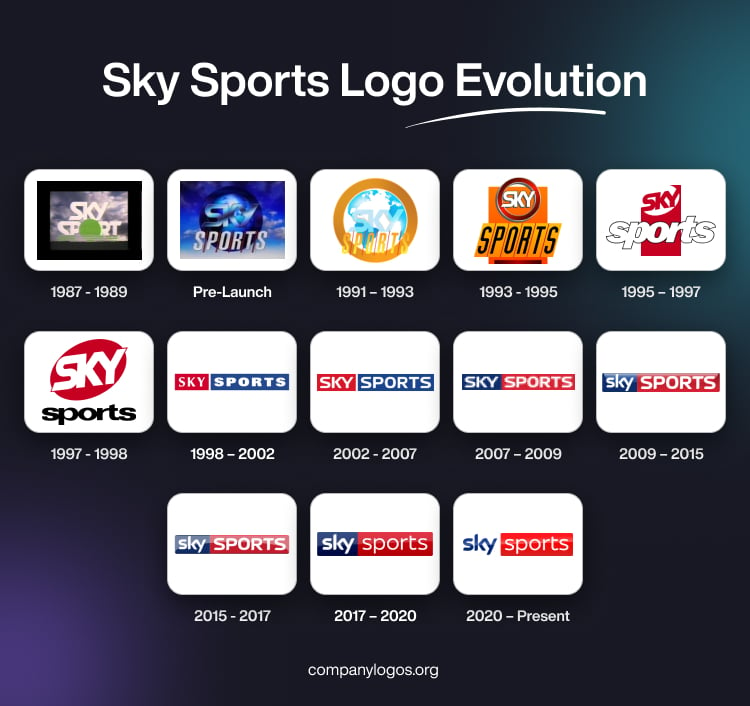
Sky Sports is the dominant force in British sports broadcasting. Founded in 1991 as the flagship component of the Sky Group, the channel has become synonymous with Premier League football, Formula One, cricket, and more. Just as its content has evolved, so too has its visual identity. The Sky Sports logo iterations show shifts in design trends, branding strategies, and audience expectations. The article delves into the various changes of the Sky Sports logo since its inception.
The Genesis of the Sky Sports Logo (1987 – 1989)
Before the launch of the Sky Sports channel, the sports coverage on Sky was represented by a logo that showed the brand name in two levels in white uppercase. With a blue sky and specks of white clouds forming the backdrop, the letter “O” in the word “SPORT” was represented by a tiny green circle. The individual letters of the brand name written in a custom sans-serif typeface were connected to each other.

(Pre-Launch)
This pre-launch logo of Sky Sports featured the word “SKY” in a white and gradient blue colour scheme superimposed on a deep blue globe. The word “SPORTS” in italics appeared in the bottom half of the globe in white colour.

(1991 – 1993)
Sky Sports was officially launched on 20 April 1991, and it replaced the sports content of Sky Channel. The initial logo of the channel reflected the design aesthetics of the early 90s. It was a fairly straightforward logo with a bold typeface and the words “Sky Sports“ in uppercase shown in two levels. The logo featured a blue-toned palette, simple block letters, and a utilitarian design that emphasised clarity over style.
The word “Sky” was shown in a blue and white colour scheme, and the word “Sports” in uppercase was shown below in italics. Featured in an orange gradient colour scheme, the individual letters in the word had adequate spacing. There were thin and short vertical lines in red separating each letter of the word “Sports”. The logo elements were enclosed within a circle having a thick and wide orange outline.

(1993 – 1995)
The 1993 logo variant designed by GRFX/Novocom featured a vertical rectangle in deep orange and a small horizontal rectangle in light orange covering its centre and bottom. The word “Sky” in white uppercase was positioned at the top of this vertical rectangle and was surrounded by a small circle having thick red and thin silver-metallic outlines. The word “SPORTS” in black uppercase was positioned on the horizontal rectangle, and the individual letters of the word were separated by thin vertical lines in red. The logo was available in a horizontal variant as well.

(1995 – 1997)
In the year 1995, the channel had embraced a more modern, stylised logo to reflect its growing prominence. A more dynamic logo was introduced, using italicised and slanted fonts to suggest motion and excitement. Designed again by GRFX/Novocom, it featured a red vertical rectangle that acted as the background for the brand name in red and white. The slightly slanted word “Sky” in red uppercase was placed against a small white background within the larger fold of the red vertical rectangle. The word “sports” in lowercase was horizontally stretched across the rectangle on both sides with a thin black outline.

(1997 – 1998)
This logo was a refinement of the previous logo where the vertical red rectangle was removed. The slanted word “Sky” in white uppercase and with interconnected letters was positioned against a red oval. Beneath it appeared the word “sports” in bold and black lowercase against a white background.

(1998 – 2002)
The 1998 logo variant was designed by Velvet mediendesign and Pittard Sullivan, and it featured the brand name in a single line horizontally. The word “Sky” in white uppercase and written in an Optima Bold typeface was placed against a red background. Similarly, the word “Sports” in bold uppercase appeared against a deep blue rectangle. The two red and deep blue backgrounds formed stretched yet separate horizontal rectangles.

(2002 – 2007)
The 2002 logo was similar to the previous iteration but with a new typeface.

(2007 – 2009)
The 2007 logo variation swapped the colours of the rectangles forming the background.

(2009 – 2015)
This period saw the separate rectangles in blue and red connected and given a glossy three-dimensional appearance with gradients. The word “sky” was written in lowercase, while “Sports” appeared in uppercase only.

(2015 – 2017)
In the 2015 variant, the respective colours (blue and red) inside the horizontal rectangle were made lighter.

(2017 – 2020)
With the rise of mobile streaming and app-based viewing, the Sky Sports logo was rebranded in 2017 by Sky Creative Nomad to reflect minimalism and digital clarity. The rectangle containing “sky” and “Sports” was given a gradient effect, while the brand name was written in a cleaner sky text sans-serif font. The word “sky” was made bold, while the word “sports” was written in a thin sans-serif typeface.

(2020 – Present)
The current logo keeps the simplicity of the 2017 version but with fine-tuned colour balance and a more modern typeface. It’s been optimised for mobile devices, smart TVs, and digital platforms. The blue box was removed, and the word “sky” was written in blue lowercase. The word “sports”, however, retained the red rectangular background.

The Elements of the Sky Sports Logo
Font
The current wordmark used in the Sky Sports logo is written using a variation of the Sky corporate font. It is a custom sans-serif font that provides maximum legibility and visual clarity across all screen sizes. The bold, minimalist, and rounded font reflects a digital-first approach, improves visual balance, and enables cross-platform scalability.
Colour
The latest Sky Sports logo employs a red, blue, and white colour palette to provide strong contrast. The colour palette is more matte and flatter and aligns with digital design trends. The colour blue evokes trust and credibility, and the colour red evokes excitement and energy.
The History of Sky Sports
Sky Sports has been a pioneer in sports broadcasting and is instrumental in introducing several firsts and innovations that have transformed the viewing experience. It was the first to bring Monday Night Football to UK audiences, which added a prime-time feel and theatrical production to weekly football coverage. The network led the way in developing interactive TV features, thereby allowing viewers to access live stats, camera angles, and match highlights at the press of a button.
It was also an early adopter of 3D sports broadcasting and briefly experimented with immersive viewing before the technology’s decline. Sky Sports has been at the forefront of the HD and UHD (Ultra High Definition) revolution. Thanks to this, the picture quality of its broadcasting has significantly enhanced in terms of picture quality. It has served a new standard for visual clarity in live sports.
Beyond the technology, Sky Sports has become renowned for its high production values. It utilises innovative camera techniques and slick studio setups. It also popularised expert analysis by bringing in former athletes and sports legends as pundits. These analyses turn them into household names and enrich the commentary with insider perspectives. These advancements have collectively elevated the way sports is consumed and understood by fans.
Interesting Facts About Sky Sports
- The acquisition of Premier League rights by Sky Sports in 1992 wasn’t just a business deal; it changed the face of English football forever. With better cameras, expert analysis, and slick graphics, Sky turned football into a polished TV spectacle.
- In 2010, Sky Sports made history by launching the first 3D sports channel in the UK by broadcasting a Premier League match between Manchester United and Chelsea. Though 3D TV didn’t last, it was a bold step in immersive viewing.
- Sky introduced the concept of Monday Night Football to British viewers in 1992, which was inspired by the American version. It added a prime-time slot and detailed pre- and post-match analysis that set a new benchmark for matchday coverage.
- Sky Sports is responsible for turning former players like Gary Neville, Jamie Carragher, and Roy Keane into respected (and often viral) football pundits. Their in-depth tactical analysis and debates have become as entertaining as the matches themselves.
- When Sky Sports launched in 1991, it was initially a free-to-air channel. It wasn’t until the Premier League rights came into play that Sky began shifting to a subscription-based model, which ultimately funded its massive investment in sports rights.
- Launched in 1998, Sky Sports News became the first dedicated 24/7 sports news channel in the UK. It’s now a go-to source for breaking sports updates and has become especially popular during transfer windows.
- Between its main channels and multi-match viewing options (like Red Button services), Sky Sports covers hundreds of matches annually, not just in football but across cricket, F1, rugby, and golf.
- Sky Sports F1 was launched in 2012, and it is the world’s only channel that is exclusively dedicated to Formula One. It provides round-the-clock F1 coverage, from live races to documentaries and in-depth team analysis.
- Sky Sports was one of the first broadcasters to offer interactive services. These allowed fans to choose different camera angles, view live stats, and access alternative commentary during games.
- The final day of football transfer windows, known as Deadline Day, has become a mini media event thanks largely to the round-the-clock coverage, dramatic countdowns, and on-location reporters of Sky Sports at club training grounds.
- While best known in the UK and Ireland, Sky Sports content is also broadcast internationally through Sky affiliates and global licensing deals. These make it a key player in international sports media.
- While often associated with football, Sky Sports has exclusive rights to several major sports, including cricket (The Ashes, ICC events), Formula One, PGA Tour golf, rugby union (Premiership Rugby), rugby league, darts, and boxing.
- Sky Sports introduced virtual studios and augmented reality graphics long before they became widespread, especially during football and F1 coverage. These help enhance storytelling and tactical breakdowns.
- In 2017, Sky Sports revamped its structure to offer dedicated channels (e.g., Sky Sports Premier League, Sky Sports Cricket). These allowed subscribers to pay for only the sports they love.
- Sky Sports is part of the Sky Group, which is owned by Comcast, one of the world’s largest media conglomerates. This relationship provides additional investment and access to broader distribution platforms.
Finally
The Sky Sports logo evolution is a case study in brand adaptation. From its humble beginnings in 1991 to today’s clean, digital-ready design, each logo iteration has served a clear purpose—either to align with technological trends, reinforce branding, or increase accessibility. Despite visual changes, certain constants remain: the blue and red colour scheme, the bold typeface, and the “Sky” + “Sports” dichotomy. These elements have ensured brand continuity, even as the world of sports broadcasting has transformed dramatically.